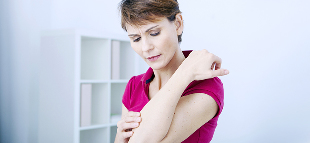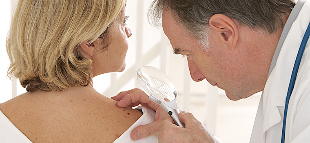Psoriasis is a non-communicable chronic disease, in most cases, affecting the skin (less – of the nail plate, and scalp). Manifests itself too dry with red spots, a few protruding above the surface of the skin (papules). By merging, the papules forming plaques, which are sources of chronic inflammation.

Psoriasis is transmitted or not?
Responding to a question, the psoriasis is contagious or not, you need to understand that the disease is not communicable, or airborne droplets, or contact, or in another way. It is impossible to get.
Due to a break in the process of exfoliation keratinized skin with scales on the body appear to be dry areas. Die of them you can't, but patients experience a serious psychological malaise because of his appearance.
The reasons of occurrence of psoriasis
Up to now, is not clearly determined, and that can psoriasis. There are different theories of the development of the disease. The experts are inclined to believe that the defeat of the skin and nails can cause:
- stress, bad experiences emotional;
- endocrine pathology;
- a hereditary predisposition;
- a failure in the functioning of the immune system, which interferes with the growth and division of epithelial cells.
Autoimmune the cause of psoriasis lies in the fact that the immune cells are T-helpers and T-killers, normally responsible for protecting the body against cancer cells, viruses, and pathogenic bacteria, are beginning to penetrate the upper layers of the skin. Here, they produce substances that activate the inflammatory process. As a result, the skin cells begin to provide, share and multiply. There is a proliferation.
The development of the psoriasis is possible and the whole of the action of several factors the list below:
- Very thin and poorly hydrated, the skin (sebum produced little).
- The frequent contact with irritating compositions – the poor quality of cosmetic products, solutions, alcohol, household chemicals.
- Too frequent of washing the body, hands (especially if you use a washcloth rigid and antibacterial soap/shower gel).
- The abuse of alcohol.
- The development of infectious diseases caused by staphylococcus, streptococcus, fungi.
- The intake of antidepressant medications, lithium carbonate, beta-blockers, a type of antiretroviral and anticonvulsant medications.
- The climate change of the belt.
- Mechanical trauma to the skin.
- A tendency to allergic reactions.
- HIV infection.
The classification of the disease
If explore the different pictures of psoriasis of the initial phase, these are variations – there are several varieties of this skin disease. According to the place of defeat is:
- Psoriasis of the scalp (manifested by itching and bleeding of the skin).
- Psoriasis of the nails (the nail plate detaches progressively from the lodge and becomes painful, it formed red spots).
- Palmo-plantar psoriasis (disease research on the feet and/or palms of the hands).
- The skin, psoriasis (dry patches occur on different parts of the body).
- Arthropathy psoriasis (amazed to see the joints).
- Sexual psoriasis (disease that covers the skin of the genitals).
Clinical forms of psoriasis:
- Ordinary or vulgar. Manifests itself flat pink papules red, small in size, which dominate slightly above the skin in good health. At the top papules covered with scales of light, which begin to detach, even at a light touch. If the treatment of psoriasis started on time, small fireplaces are combined in large.
- Pericardial. More common in obese people, hypofunction of the thyroid, diabetes. The symptoms of psoriasis this following form: the papules are of a bright red colour, and above them are rendered in yellow-grey glitter. The pads are touching the skin folds – armpits, the area under the breasts in women. The patients complain of itching, burning sensation.
- Seborrheic. Psoriasis can occur on the head, contours, options, load-labial folds, between the shoulder blades, on the chest. The boundaries of the spots are not clearly expressed. The fur is yellow-grey. If you look at the picture of psoriasis on the head, you are having the association with such a common fungal disease, such as dandruff.
- Palmo-plantar. The disease is common in people aged 30 to 50 years, whose work is related to a physical work. If this shape can be observed rashes on the body.
- And pustular. On the body are formed pustular elements. Medicine secrete additional variant of the form pustular – psoriasis Tsumbush. It is often idiopathic (primary) - on the skin of bubbles appear, which turn into pustules. The pustules are broken into and dry out. Later, they seem to be typical of the disease peeling rash. And secondary) with a benign course. In this case, the pustules appear on the surface typical of psoriatic plaques due to irritation of the action of drugs.
- Another kind of form pustular – psoriasis Barbera. It only affects the soles and the palm. On the skin are rendered in purulent pustules. They are not exposed, with time, turn into dark dry crust. Psoriasis Barbera distinguishes the symmetry of defeat.
- Arthropathy (joint). The severe form. Common in patients who have skin rashes. Usually occurs at the end of five-six years after the onset of the first symptoms of the disease, if the treatment of psoriasis was illiterate. The pathology of the articulation of the system may be different, starting not expressed arthralgia, not leading to change within the finishing device, deforming ankylosis (joint is completely immobile).
- Psoriatic erythroderma. Is a consequence of vulgar or exudative psoriasis. Affects almost all the leather. It becomes red, dotted with a large number of scales dry. The body temperature increases, we observe an increase of lymph nodes (especially femoral and inguinal). If the patient does not know how to treat psoriasis, it may be the loss of hair, brittle nails.
According to the criterion of the season of recurrence of psoriasis are divided into:
- years;
- the winter (the most common);
- indeterminate.
The symptoms of psoriasis
Dominate the symptoms of psoriasis depends on the treatment, therefore, the first reception, the doctor performs a thorough examination of the patient, thoroughly studying the space localization of psa households.
Most often the disease is manifested by the winter. In the summer, under the effect of solar radiation, signs of psoriasis can disappear completely. However, during the "years" in the form of the pathology of exposure to the sun, on the contrary, you need to avoid. In the period of exacerbation of the patient complains of a very strong itching. The defeat of the nail plate may occur only 25% of patients.
When the disease of the skin of the head the hairs are not involved in the pathological process. First off the skin. With time, the area of the rash may "redeem" on the area of the neck, behind the ears. The inflammatory process due to a very rapid division of keratinocytes.
Psoriasis of the hands and feet, the stratum corneum thickens and is covered by deep cracks. The photo of psoriasis on the initial phase shows pustules transparent content. Later, they become white and grow in the dark scars.
In regards to the nail plate, these are the most common two types of lesions:
- The nail is covered with alveoli, which are in appearance similar on the traces of the beatings ("the type of thimble").
- The nail changes color and begins to flake, which looks like a fungal disease. Through the nail plate varies psoriatic papule, surrounded by a red border.
The phase of psoriasis
While up to now, there is a debate on what is psoriasis and specifically what may cause its appearance, the stage of the disease is already well studied. Three:
- Progressive (initial). On the surface of the skin tumors appear in the form of an eruption, having a tendency to the increase of the periphery. They apply on healthy skin, and form an oval or rounded plate. The spots are pink or red color. Flaking of the crust they do not have the scales whitish. The edges of the pockets a bit closed. As a result, the combing of new eruptions.
- For the hospitalized patients. Occurs within one to four weeks after the first symptoms of psoriasis. Plate become more clear. New eruptions do not appear, old slowly absorbed. Emphasizes the healing of the papules in the direction of the center to the edges, because of what the form is which. The entire surface of the wound-healing homes covered with white scales.
- Regressive (damped). The color of the psoriatic plaques is virtually impossible to distinguish the health of the skin. Reduces itching. Around homes have formed a "collar of the Municipality", which is a ring of tight keratinized skin. If the patient uses the quality of the ointment of psoriasis, a regression phase lasts about a month. In the contrary case, the mitigation process may take up to six months.
The task of the patient who has been diagnosed with psoriasis – all the time to hold the disease in remission.
If You find similar symptoms, contact your doctor immediately. Easier to prevent disease than to treat the consequences.
How is the diagnosis of psoriasis

The diagnosis of psoriasis takes care of a dermatologist. The procedure is based on the outer side of the inspection, the assessment of the condition of the skin and nails, the study of the location of the lesions. No additional analyses explicit symptoms are not affected. If you encounter difficulties with diagnosis, we take a sample of the skin with inflamed phase (biopsy), who are studying in laboratory conditions.
When the complaints of pain in the joints is due to the x-ray. Also assigned to a blood test, to verify the absence of other types of arthritis. To exclude a fungal infection in a test using potassium hydroxide.
How to cure psoriasis
The treatment of psoriasis is complex. It includes:
- general therapy;
- the local treatment;
- physiotherapy.
Before determining that a cure for psoriasis, your dermatologist determines the stage of the disease, its clinics, the prevalence of the process. When the designation of the drugs takes into account the age of the patient, and the presence of its co-morbidities. Usually sneaking the safest for the health of the drugs, reducing the number of side effects. If they do not provide transition of psoriasis in a phase of regression, the treatment is adjusted.
The system of medicines for psoriasis
The drugs, taken inside, using the moderate and severe stages of psoriasis. These include:
- The derivatives of vitamin A (retinoids). Reduce the speed of maturation of keratinocytes. Normalize the differentiation and maturation of cells.
- Immunosuppressants. Reduce the activity of T-cells, causing enhanced cell division of the epidermis.
- Drugs for the treatment of malignant tumors. Inhibit the reproduction and growth of abnormal cells of the skin.
Physical therapy in psoriasis
The procedures of physiotherapy significantly improve the health of patients with psoriasis. In some cases, they can completely abandon the medication. The most commonly used are the following:
- Phototherapy selective. The skin irradiated with UV at a wavelength of 280-320 nm. Assigned 15 to 35 procedures.
- Photochemotherapy (PUVA-therapy). The method assumes the sharing of a photosensitizer to the interior, and the UV wavelength external radiation. The uv rays penetrate deep into the skin, and a photosensitizer, which blocks the process of DNA synthesis of skin cells, reduces the speed of their division. The course duration is 20 to 30 procedures.
- The laser therapy. Apply radiation of different wavelengths. The laser provides an acceleration of resorption of platelets, prevents the formation in their place of scars.
- The use of monochromatic uv radiation. Every home in alternation deal with tube/the source of the UV laser. The skin health is not affected. The method is efficient if a hit of less than 10% of the skin. Treatment duration – 15 to 30 sessions.
- Electric. It is a low-impact electrical impulses to the brain for 20-60 minutes. As a result, the patient calms down, normalizes the work of the central nervous system, psoriatic plaques begin to resolve.
- UZ-therapy. Is a decongestant, antipruritic and analgesic means. Accelerates the resorption of scars. If necessary, can be combined with phonophoresis. To achieve the therapeutic effect necessary to 7 to 14 of the session.
- The magnetic therapy. Has purifying effect on the body. Relieves inflammation, reduces itching and burns, helps to get rid of the pain in the joints.
- The treatment apitoxine With the help of the electrophoresis instrument or of the ultrasound is introduced into the body of the bee venom. It is characterized by resolving and anti-inflammatory effect, normalizes metabolism.
- The hyperthermia. The dead psoriasis fabric is heated thermal padding of the mixture at a temperature of 40 degrees. The treatment helps to improve the functioning of the immune system, reduce the negative impact of the disease on the skin.
The diet of psoriasis
Authorized by the products at the time of exacerbation of psoriasis are:
- fruits (apples, apricots, peaches);
- fruit juice;
- vegetables (beets, potatoes, radish, melon, pumpkin);
- the green;
- berries (all except red);
- lean meat (beef, veal, turkey, rabbit) – up to 200 grams per day;
- nuts;
- leaner fish;
- dairy products, cottage cheese and cheese;
- whole-grain bread;
- marine cabbage.

Patients with psoriasis may not have:
- the dishes;
- red fish;
- animal fats;
- eggs;
- the pork and duck;
- cooking.
It is forbidden to drink coffee, soft drinks and alcoholic beverages. It is desirable to limit the consumption of sugar. To clean the body two times per week, it is recommended fasting days – vegetables, apple, or kefir.
























